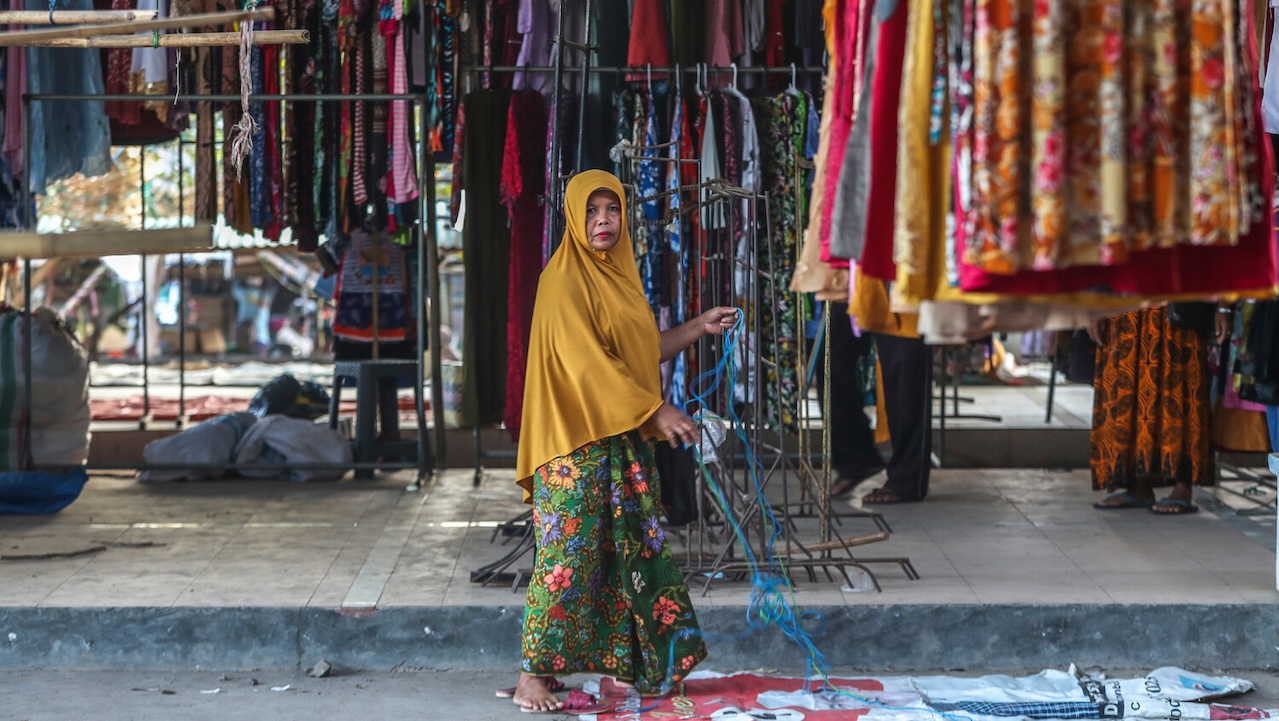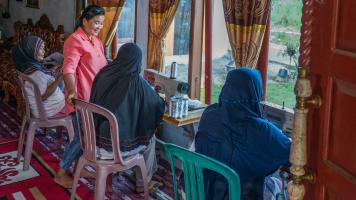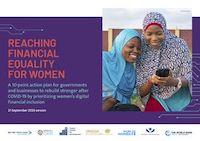
Women entrepreneurs across the globe face a $1.7-trillion finance gap. Photo credit: ADB.
Providing tailored green financing, deploying technology and bridging the digital divide, and ensuring a supportive environment with the right policies are key.
More women continue to venture into entrepreneurship, braving numerous barriers that could spell failure.
One of their biggest challenges is getting access to credit, with women entrepreneurs across the globe facing a $1.7-trillion finance gap. Women-led micro, small, and medium-sized enterprises (MSMEs) also grapple with limited access to markets as well as information, education, and skills training; discriminatory laws and regulations and social norms; and lack of networks, among others.
At a recent webinar from the Asian Development Bank, United Nations Development Programme (UNEP), and UN Women, a panel of experts examined ways to ensure women-owned businesses could scale, amid the rising imperative to shift to a green economy. They agreed that as women entrepreneurs continue to face challenges, there is a need to create and seize opportunities to unlock the sector’s potential to thrive and ensure resilience.
Speaking at the webinar, ADB Climate Change and Sustainable Development Department's Gender Equality Division Director Samantha Hung said that in Southeast Asia alone, a green recovery from the COVID-19 pandemic has the potential to create $172 billion worth of investment opportunities annually as well as 30 million jobs by 2030. “Despite these very impressive figures, we know that women entrepreneurs continue to face barriers,” she said. She noted that many have yet to adopt sustainability principles in their businesses.
Marlene Nilsson, deputy regional director, Regional Office for Asia and the Pacific at UNEP, stressed the need to provide women entrepreneurs with the means to succeed in the green economy. "When women, entrepreneurs thrive, economies grow, societies prosper, and the planet benefits,” she said.
Both agree that unlocking opportunities in the green economy requires meaningful reforms and solutions, some of which are already yielding results.
Providing tailored green finance solutions
Nilsson acknowledged the success of programs that tailor green finance solutions for women-led enterprises.
UNEP, with UN Women, for instance, rolled out the EmPower program in 2018 to make loans more accessible to women. According to UN Women, the program works with banks to develop loan products that allow women and other marginalized groups to acquire renewable energy equipment and other clean technologies. The first phase benefited some 473 women-led MSMEs, and the second phase, launched in 2023, is expected to support another 1,600.
In 2021, ADB launched the Women’s Finance Exchange (gWFX ) initiative to provide information, innovation, and capital to help women-led enterprises access green financing. The platform offers tailored support to financial institutions to enhance their capacity to deliver financial services for women entrepreneurs. It also explores funding and co-financing opportunities to boost lending to women and women's businesses and identifies technology solutions for sustainable financing for women. It has so far provided $1.7 million in financing to 1,448 women-owned and -led SMEs through gWFX-supported financial service providers. It has reached 350 women and 152 financial institutions through trainings and entrepreneurial support and knowledge-sharing events, respectively.
Last year, ADB also partnered with Mastercard to roll out an initiative that seeks to bridge the financing gap for MSMEs in the Asia and the Pacific, with a focus on women-led or -owned MSMEs and green finance. The initiative will leverage a $5-million grant from Mastercard to financial institutions, to catalyze lending toward MSMEs. The grant will support up to $1 billion of ADB financing over a 4-year period, providing risk-reduction capital, performance incentives, and capacity building for financial institutions. The initiative will initially target Georgia, India, Indonesia, Malaysia, the Philippines, Thailand, and Viet Nam.
Women eco-entrepreneurs can also tap private sector financing. “There is a lot, actually, of funding out there now, especially with the rising trend [for green financing],” said April Ong Vaño, head of environmental, social, and governance at venture capital company Quest Ventures. Women entrepreneurs could leverage the growing sustainability trend to connect with potential investors to access these funds, she said.
Lean into tech
The panel also emphasized the importance of deploying technology and bridging the digital divide through trainings and policies.
“Digital transformation is really a game changer for women-led businesses—small ones in particular,” said Anthea Mulakala, project director at the APAC Cybersecurity Fund. She said digital tools lower the barriers to entry and allow women entrepreneurs to sell their green products online, tap into alternative sources of financing, or use artificial intelligence (AI) and other internet solutions to advance their business.
She cited existing resources that help women embrace digital, including The Asian Foundation’s Go Digital ASEAN program, which seeks to strengthen MSMEs’ digital footprint. According to the program’s website, the first phase trained over 225,000 MSMEs and workers from underserved communities in Southeast Asia, with a special emphasis on women. The second phase expanded the program’s reach, providing advanced and specialized training on business and financial literacy, digital marketing, cybersecurity, and carbon footprint reduction to an additional 215,896 MSME owners and workers across the region.
Mulakala warned though digital transformation brings risks, noting cyberthreats against MSMEs in Asia have increased 500%, leading to loss of customer data, or worse, business closures. It comes down to basic cyber hygiene, she said. “Some basic tools that can be learned by small businesses will really protect them and make them more resilient.”
But even more basic technology solutions could make a difference. In agriculture, for instance, this can come in the form of solutions like messaging and video calling app WhatsApp which enterprises can use to access weather forecasts as well as information when to plant seeds. “That could be very simple, but very transformational,” said Giulia Ajmone Marsan, head of startups and inclusion at the Digital Innovation and Sustainable Economy Center, Economic Research Institute for ASEAN and East Asia.
ADB has also advocated deploying technology for development. For instance, it leaned on technology to help address extreme heat in parts of Asia, as it is a major issue for women in the region, particularly for informal workers or those in agriculture.
Hung said satellite technology can give women early warning through phone text messages, while solar technology can be deployed for cooling and irrigation, in the case of Kampot pepper farmers and producers in Cambodia.
Deploying solar technology not only helps safeguard Kampot crops from extreme heat and drought but also strengthens the resilience and economic security of the women who are central to the agriculture sector’s success. The solution emerged as the winning entry for an ADB innovation challenge to empower rural women, advance food security, and strengthen resilience to extreme heat.
Emma Gooley, ASEAN public sector lead at Microsoft, said the software giant supports women entrepreneurs in agriculture through initiatives like Code Without Barriers, which provides digital literacy training and a support ecosystem. Microsoft also invests to scale and upmarket traditional industries like agriculture, utilizing technology to enhance efficiency and accessibility. She also encouraged women to use Linkedin Learning and other online platforms to keep up-to-date on developments in tech and sustainability.
Creating a supportive environment
Ensuring a supportive environment for women entrepreneurs also entails designing and implementing the right policies, collaboration among stakeholders, and establishing institutional connections, the panel said.
Nilsson noted the need to build financial digital and policy ecosystems that genuinely support women and entrepreneurs to unlock their full potential to drive green innovation.
Ajmone Marsan said the ecosystem should support women from primary school to venture capitalists and throughout the entire education, innovation, and entrepreneurship cycle.
Addressing the needs of women entrepreneurs requires collective efforts, she added. “We need to work together across different policy domains. Otherwise, inevitably, if the strategy is just targeting one tiny little aspect, it can provide a partial solution, but it won't be something that is truly addressing the problem from its roots.”
Vaño also stressed the need for entrepreneurs to find strategic partners and investors who share a long-term vision in creating business opportunities. She also urged entrepreneurs to ensure they have a strong, competent team, as is it is one of the things investors look for.
Nilsson advised entrepreneurs to leverage their networks and engage with industry, government programs, and sustainable-focused funds to scale their impact in navigating complex regulatory landscapes.
She noted that even with policies in place, it is crucial to establish institutional connections. “You can have policies, but if there's no execution, and if there are no resources behind those policies, they're sort of dead in the water,” she said.


